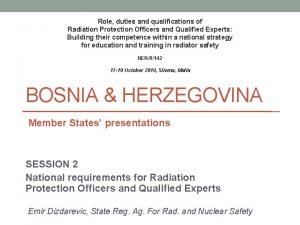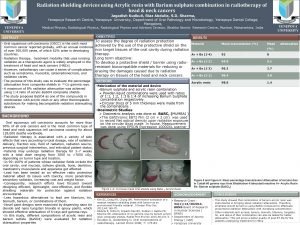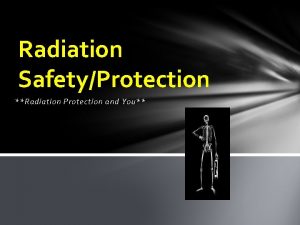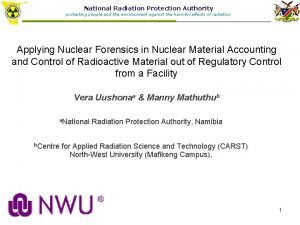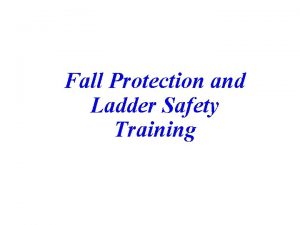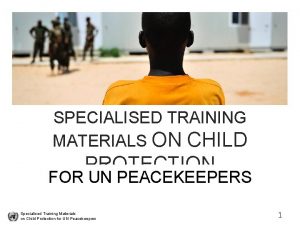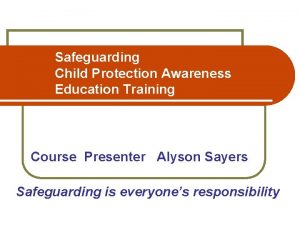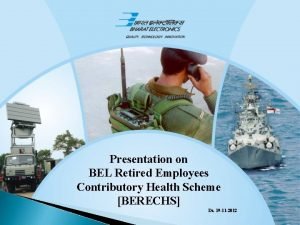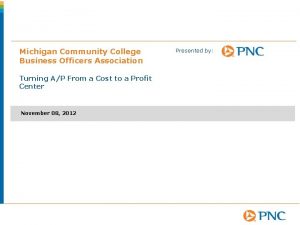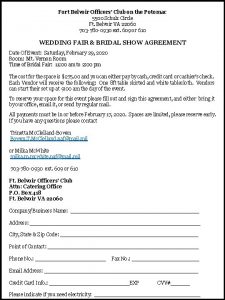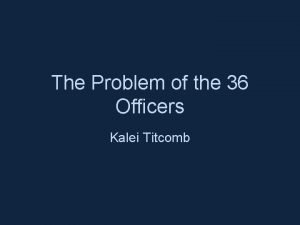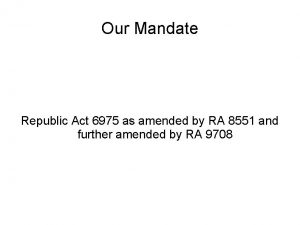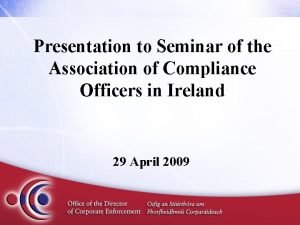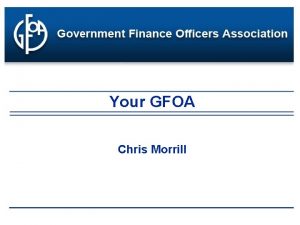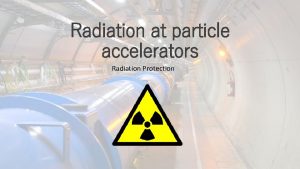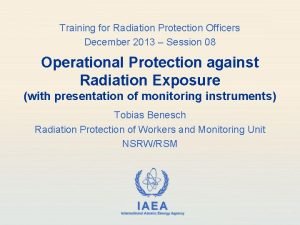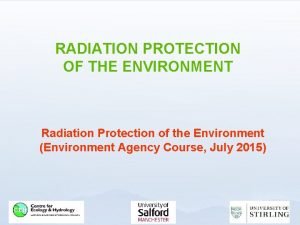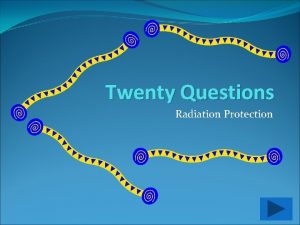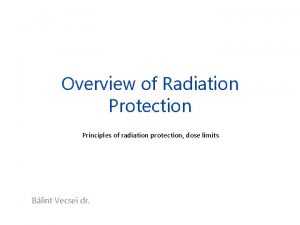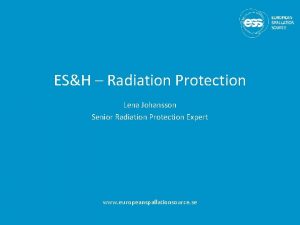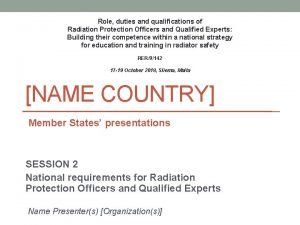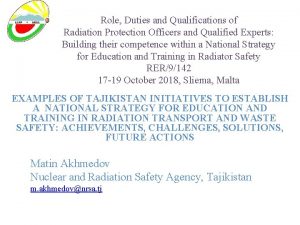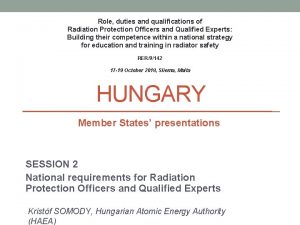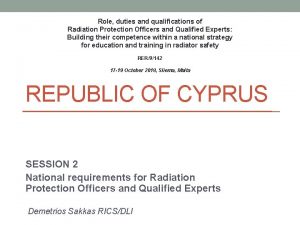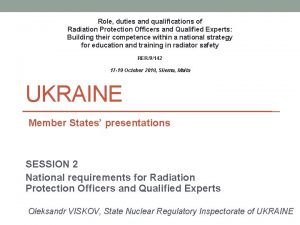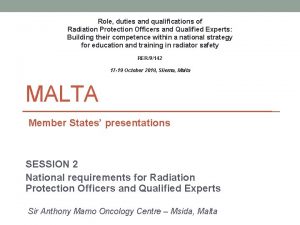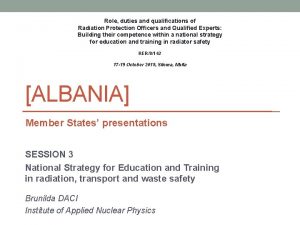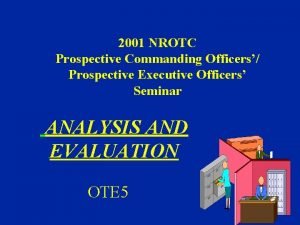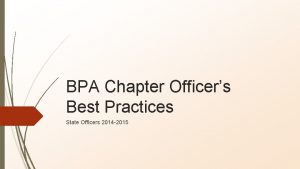Training of Radiation Protection Officers at Medical Radiation

























- Slides: 25

Training of Radiation Protection Officers at Medical Radiation Facilities Transport of radioactive sources IAEA International Atomic Energy Agency

Overview • Introduction • Movement of radioactive sources within the medical facility • Transport of sources outside the medical facility IAEA

Introduction Requirement 2: Establishment of a legal and regulatory framework The government shall establish and maintain a legal and regulatory framework for protection and safety and shall establish an effectively independent regulatory body with specified responsibilities and functions. • The government shall ensure that the transport of radioactive material is in accordance with the IAEA Regulations for the Safe Transport of Radioactive Material and with any applicable international conventions. IAEA 3

Introduction BSS definitions Consignor: any person, organization or government that prepares a consignment for transport Consignee: any person, organization or government that is entitled to take delivery of a consignment. Consignment: any package or packages, or load of radioactive material, presented by a consignor for transport. • The licensee of a radiation therapy facility may be both a consignee and a consignor: • Receipt of radioactive materials is a regular occurrence for the nuclear medicine facility • Shipments may take place when: • the facility has a cyclotron or laboratory that sends radiopharmaceuticals • expired generators, old sealed calibration sources or radioactive liquids should be returned to the supplier or disposed off-site IAEA

Introduction • The detailed requirements for the safe transport of radioactive material, are given in the IAEA SSR-6. • Emergency arrangements during the transport of radioactive material should be in place. • The licensee and the RPO of the nuclear medicine facility should be familiar with these regulations. IAEA

Introduction • Transportation of Radioactive material may posed exposure risk to members of public • Transportation of radiopharmaceutical to hospital • Transportation of radioactive waste inside and outside hospital • A safe transport of Radioactive material shall be considered to ensure a minimum risk to workers, public and the environment IAEA

Movement of radioactive sources within the medical facility • If the administration of radiopharmaceutical to the patient takes place far from the dispensing room, use a transport container with absorbent pads • Make sure that a warning sign is on the container together with patient name, activity and date • Travel by the most direct route avoiding more heavily occupied areas IAEA

Transport of sources outside the medical facility - Definintions Radioactive material (RAM): • …. . any material containing radionuclide where both the activity concentration and the total activity in the consignment exceed the values determined in SSR-6 • Material that is not RAM is not subject to regulatory control by requirements of SSR-6 IAEA

Transport of sources outside the medical facility (preparatory actions) • Make sure that the packaging is appropriate to the content + PACKAGING = RADIOACTIVE CONTENTS PACKAGE • Make sure the package is in good condition before the transfer and meets all requirements • Ensure that the source is locked • Installing appropriate signage IAEA

Transport of sources outside the medical facility (shipping) Required: • Appropriate statement of the content (e. g. vacuum or transferred source) • Appropriate documentation for the transport of radioactive material • Placarding Vehicle carrying radioactive material • Check the vehicle and the driver area IAEA 70 Danger recognition 2911 UN Number the lower number identifies the substance, while the upper number is a key for the threat it may pose

Transport of sources outside the medical facility • Packaging properly prepared for shipment • Labels of radioactive material IAEA

Package types • Excepted • Industrial Package , Type 1, 2 and 3 • Type A • Type B(U) • Type B(M) • Type C IAEA Each type of package has to fulfil specific requirements and undergo tests.

Excepted • Used for the transportation of limited quantities of radioactive material that correspond to a low radiological hazard. The dose rate at the surface of the package is: <5 μSv/h • It can be of various types such as chipboard boxes, plastic or metal drums • Basic shielding IAEA

Excepted Empty containers containing radioactive materials may be transported as excepted packages with the provision that: • They are in good condition and securely closed. • All the warnings from the previous transfer has been removed or covered. IAEA

Type A • Quantities of radioactive material corresponding to low radiological risk (limited to the boundaries of the package). • Designed to withstand normal conditions of transport • May have different packaging - can, box, lead pot, polystyrene insert, steel container • In case of an accident, specific protective actions are required e. g. exclusion area, decontamination area etc IAEA

Type B(U) and B(M) • Large quantities of radioactive material, e. g. Co 60 250 TBq • Usually huge metal drums or containers with heavy shielding to withstand severe accidents. • Radiological risk is likely in an accident and requires specific protective actions. • In case of an accident during road transportation, the consideration of the application of specific protective actions must be taken into perspective. IAEA

Type C • Larger quantities of radioactive material • Shielding to withstand even airplane accidents IAEA

Fire resistance • • Excepted - Type Α Minimum Type Β 30 min in average temp. 800οC Type C 60 min in average temp. 800οC IAEA

Categorization The categorization is performed according to requirements based on : • Transport Index (TI) • Maximum surface dose rate TI = max dose-rate @ 1. 0 m (m. Sv/h) 10 1. 0 m IAEA

Categorization Category Surface dose rate Transport Index I - White < 0, 005 m. Sv/h 0 II- Yellow 0, 005 - 0, 5 m. Sv/h 0 to 1 III- Yellow 0, 5 - 2 m. Sv/h 1 to 10 III- Yellow(*) 2 - 10 m. Sv/h above 10 (*) transferred under special settlement The maximum dose rate must not exceed 10 m. Sv/h, in any case. IAEA

Labeling Each package must be labeled depending on the category to which it belongs. Scope: • identification of packages containing radioactive material and content (in case of an accident or disaster) • provide instruction in handling and storage; irradiation of the people contacting the transportation IAEA

Labeling • Labeling must be: ü easily visible and legible ü Include the number of UN (# # UN) related to dangerous goods contained in the package • Each label must indicate the following information: ü Content (e. g. radionuclide) ü Activity (MBq. k. Bq, GBq, TBq) ü Transport Index (pure number) IAEA

Vehicle Placards 3 placards on vehicle IAEA

IAEA

Where to find more information ü FOOD AND AGRICULTURE ORGANIZATION OF THE UNITED NATIONS, INTERNATIONAL ATOMIC ENERGY AGENCY, INTERNATIONAL LABOUR ORGANIZATION, OECD NUCLEAR ENERGY AGENCY, PAN AMERICAN HEALTH ORGANIZATION, UNITED NATIONS OFFICE FOR THE COORDINATION OF HUMANITARIAN AFFAIRS, WORLD HEALTH ORGANIZATION, Preparedness and Response for a Nuclear or Radiological Emergency, IAEA Safety Standards Series No. GSR Part 7, IAEA, Vienna (2014)(to be updated). ü ü IAEA Safety Standards, Regulations for the Safe Transport of Radioactive Material, SSR-6, 2012 Edition ü INTERNATIONAL ATOMIC ENERGY AGENCY, Predisposal Management of Waste from the Use of Radioactive Materials in Medicine, Industry, Research, Agriculture and Education, Safety Standards Series, DS 454 EUROPEAN ASSOCIATION OF NUCLEAR MEDICINE (EANM), EANM Dosimetry Committee guidance document: good practice of clinical dosimetry reporting, Eur J Nucl Med Mol Imaging, DOI 10. 1007/s 00259 -010 -1549 -3, 2010 IAEA 25
 International foundation for protection officers
International foundation for protection officers Chief medical officers physical activity guidelines
Chief medical officers physical activity guidelines Training officers consortium
Training officers consortium Radiation protection officer qualifications
Radiation protection officer qualifications Barium sulphate board for radiation protection
Barium sulphate board for radiation protection Cardinal principles of radiation protection
Cardinal principles of radiation protection National radiation protection authority namibia
National radiation protection authority namibia Who trains employees that work on scaffolds
Who trains employees that work on scaffolds Fall protection training outline
Fall protection training outline Child protection training materials
Child protection training materials Child protection awareness training
Child protection awareness training Bel retired employees health scheme
Bel retired employees health scheme Pnc intellilink
Pnc intellilink Fort belvoir officers club
Fort belvoir officers club Chief instructional officer
Chief instructional officer California community college chief instructional officers
California community college chief instructional officers 36 officers problem
36 officers problem Police officer pledge
Police officer pledge The tell tale heart stylistic devices
The tell tale heart stylistic devices Police officers pledge
Police officers pledge What were the military duties of ranked officers othello
What were the military duties of ranked officers othello Canton police department records
Canton police department records Ffa president symbol
Ffa president symbol Association of compliance officers in ireland
Association of compliance officers in ireland Georgia government finance officers association
Georgia government finance officers association Officers list
Officers list



